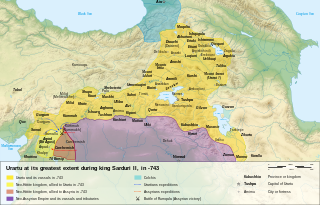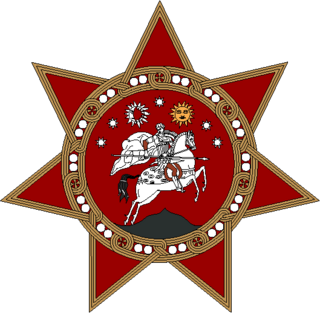Related Research Articles

In classical antiquity and Greco-Roman geography, Colchis was an exonym for the Georgian polity of Egrisi located on the coast of the Black Sea, centered in present-day western Georgia.

Diauehi (Georgian დიაოხი, Urartian Diauehi, Greek Taochoi, Armenian Tayk, possibly Assyrian Daiaeni) was a tribal union located in northeastern Anatolia, that was recorded in Assyrian and Urartian sources during the Iron Age. It is usually (though not always) identified with the earlier Daiaeni(Dayaeni), attested in the Yonjalu inscription of the Assyrian king Tiglath-Pileser I's third year (1118 BC) and in later records by Shalmaneser III (845 BC). While it is unknown what language(s) they spoke, they may have been speakers of a Kartvelian, Armenian, or Hurrian language.
The Battle of Basiani was fought, in the 13th century, between the armies of the Kingdom of Georgia and the Seljuqid Sultanate of Rum in the Basiani valley, 60 km northeast of the city of Erzurum in what is now northeast Republic of Turkey. The battle is variously dated between 1202 and 1205, but 1203 or 1204 has lately been given preference. The contemporary Muslim chronicler Ibn Bibi places the battle in 598 AH. The modern Turkish historians identify the castle of Micingerd (Mazankert) as the location of the battle.
Sien is one of the first historically-confirmed rulers of the Kingdom of Diaokhi, a confederation of proto-Georgian tribes. Ruling toward the end of the 12th century BCE, he is known from Assyrian sources describing the invasion of his kingdom by Tiglath-Pileser I in 1112 BCE.
For articles related to Georgia, see Category:Georgia (country)

Menua, also rendered Meinua or Minua, was the fifth known king of Urartu from c. 810 BC to approximately 786 BC. In Armenian, Menua is rendered as Menua. The name Menua may be connected etymologically to the Ancient Greek names Minos and Minyas.

Argishti I, was the sixth known king of Urartu, reigning from 786 BC to 764 BC. He founded the citadel of Erebuni in 782 BC, which is the present capital of Armenia, Yerevan. Alternate transliterations of the name include Argishtis, Argisti, Argišti, and Argishtish. Although the name is usually rendered as Argišti, some scholars argue that Argisti is the most likely pronunciation. This is due to the belief that the Urartians used the cuneiform symbol š to voice an s-sound, as opposed to representing the digraph sh.

Giorgi Aleksandresdze Melikishvili was a Georgian historian known for his fundamental works in the history of Georgia, Caucasia and the Middle East. He earned international recognition for his research on Urartu.

Tao is a historical Georgian district and part of historic Tao-Klarjeti region, today part of the Eastern Anatolia region of Turkey. Its name derives from the ancient proto-Georgian inhabitants of this area, known as Taochi.

Aryan Kartli or Arian Kartli was a country claimed by the medieval Georgian chronicle "The Conversion of Kartli" to be the earlier homeland of the Georgians of Kartli.
David of Kakheti was a Choreposcopus of Kakheti, a principality of Eastern Georgia, who ruled from 976 until his death 1010.

The Tarkhan-Mouravi is a Georgian noble family, claiming descent from the Shamkhal dynasty of Tarki, in Dagestan. Originally known as Saakadze (სააკაძე), they acquired, in the 1640s, the title of prince (tavadi) and the new surname, which is a composite of the two hereditary offices, mouravi and tarkhan. The family was reconfirmed as the princes (knyaz) by the Russian Empire in 1826 and 1850. The cadets continued to be called Saakadze and remained members of the untitled nobility (aznauri) until 1881 when they were also elevated to the princely rank.

The Arsacid dynasty or Arshakiani, a branch of the Arsacid dynasty of Parthia, ruled the ancient Kingdom of Iberia from c. 189 until 284 AD. The Arsacid dynasty of Iberia was succeeded by the Chosroid dynasty.

Urartu was an Iron Age kingdom centered around Lake Van in the Armenian Highlands. It extended from the eastern bank of the upper Euphrates River to the western shores of Lake Urmia and from the mountains of northern Iraq to the Lesser Caucasus Mountains. The kingdom emerged in the mid-9th century BC and dominated the Armenian Highlands in the 8th and 7th centuries BC. Urartu frequently warred with Assyria and became, for a time, the most powerful state in the Near East. Weakened by constant conflict, it was eventually conquered by the Iranian Medes in the early 6th century BC. Archaeologically, it is noted for its large fortresses and sophisticated metalwork. Its kings left behind cuneiform inscriptions in the Urartian language, a member of the Hurro-Urartian language family. Since its re-discovery in the 19th century, Urartu, which is commonly believed to have been at least partially Armenian-speaking, has played a significant role in Armenian nationalism.

The 1991–1992 Georgian coup d'état, also known as the Tbilisi War, or the Putsch of 1991–1992, was an internal military conflict that took place in the newly independent Republic of Georgia following the fall of the Soviet Union, from 22 December 1991 to 6 January 1992. The coup, which triggered the Georgian Civil War, pitted factions of the National Guard loyal to President Zviad Gamsakhurdia against several paramilitary organizations unified at the end of 1991 under the leadership of warlords Tengiz Kitovani, Jaba Ioseliani and Tengiz Sigua.

The collapse of the Georgian realm was a political and territorial fragmentation process that resulted in the dynastic triumvirate military conflict of the Bagrationi monarchs and war of succession in the united Kingdom of Georgia culminating during the second half of the 15th century.

State Council of the Republic of Georgia was a temporary supreme governing body of the country, which was established in 1992 after the self-liquidation of the Military Council of the Republic of Georgia.
Asya was a ruler of the Kingdom of Diaokhi, a confederation of proto-Georgian tribes, who reigned around the middle of the 9th century BCE. He is known from Assyrian sources describing the military campaigns of Shalmaneser III.
Ali ibn Shuab al-Tiflis was a leader of the Emirate of Tiflis, an Arab state in Georgia that reigned from 829 to 833. A member of the Shuabid dynasty, he was a subject of the Abbasid province of Arminiya and was appointed to replace a rebellious emir. His short reign was marked by the continuation of Tiflis's conflict with Christian Georgia.
References
- 1 2 Chkhartishvili 2014, p. 216.
- 1 2 Chkhartishvili 2014, p. 213.
- ↑ Kavtaradze 2002, p. 80.
- ↑ Suny 1994, p. 6.
- 1 2 Melikishvili 1970, p. 375.
- ↑ Asatiani & Janelidze 2009, p. 16.
- ↑ Melikishvili 1970, p. 376-377.
- ↑ Melikishvili 1970, p. 377.
- ↑ Melikishvili 1970, p. 378-379.
- ↑ Asatiani & Bendianashvili 1997, p. 30.
- ↑ Asatiani 2001, p. 32.